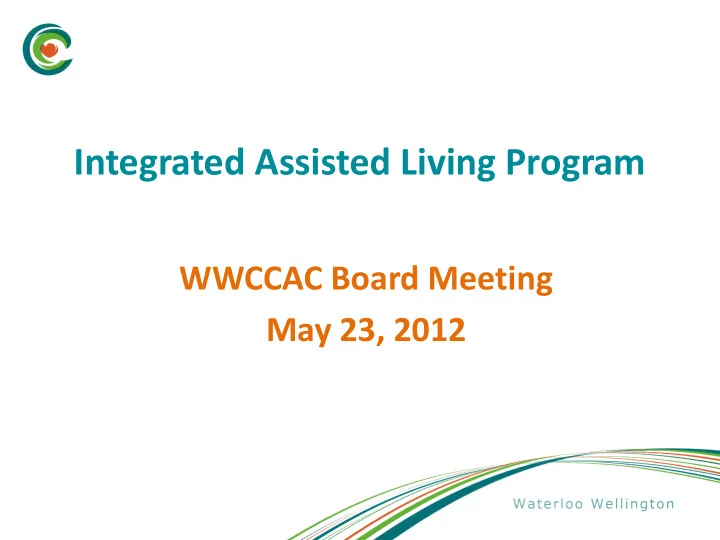

Integrated Assisted Living Program WWCCAC Board Meeting May 23, 2012
History of IALP • Waterloo Wellington Seniors Supportive Housing Initiative researched and proposed models for supportive housing (2009) • Aging at Home Year 2 funding – innovative solutions to support seniors aging at home; reduce ALC, prevent ED visits • 8 neighbourhoods with approx. 30 clients each (currently approx. 300 clients) • Goals of more effective chronic disease management, better primary care linkages, integration with community partners as well as establishing a rural model
In Home Supportive Housing “WWCCAC” Supportive Housing for Seniors • Assisted living services for seniors similar to traditional “supportive housing” basket of services but in the senior’s home of choice • Able to deliver to more people without waiting for infrastructure • CCAC uniquely positioned to provide servi ces
The IALP Client Perspective • Non-IALP 86 yr old with serious concerns was sent for acute care assessment. Physician indicated a critical medical situation and family called in. Senior returned home as IALP client and accessed 24/7 PSW many times. PSW staff able to intervene proactively when issues arose. After 4 ½ months, client stable, healthy, attends activities. A “new lease on life”.
IALP Neighbourhoods Chosen based on the analysis of a number of data sources linked to postal codes: • Seniors Supportive Housing & Wellness Initiative • Emergency Department visits and length of stay • RAI-HC assessment data – MAPLe score and age • Consultation with Case Managers
IALP – Purpose and Guiding Principles • Flexible, robust and reliable personal support and homemaking services to support aging in place and demonstrate outcomes • Basic activation, recreation needs met through access to appropriate services and programs • Supports maintenance and/or enhancement of health outcomes while avoiding duplication of services
Services and Partnerships 24/7 Personal Support Response IADLs System Senior at Risk Chronic Recreation Disease Activation Management 7
IALP – Year 1 Evaluation • What are the clinical outcomes as measured by RAI-HC for IALP clients compared with those with similar needs among general long stay WWCCAC? • What is the subjective quality of life of IALP clients compared with general long stay WWCAC population?
IALP – Year 2 evaluation
IALP Year 2– Key findings related to ED/ALC Priorities • Shorter hospital LOS (IALP 13.2 days vs. 22.5 days) • Less likely to be admitted to hospital 10 or more times over 18 month period • Less likely to be admitted to hospital after an ED presentation (24% IALP compared to 32.8% selected adult long stay) • Less likely to be designated ALC (34% of IALP clients compared with 43.1% of selected long stay adult clients) • Much less likely to be on a LTCH waitlist
IALP Quality Indicators Improvement in Client Outcomes • Less likely to be medically unstable and/or frail • More likely to have achieved greater health stability with less medical complexity after 1 year of IALP • Less depressed overall • Less likely to struggle with IADLs • Less likely to be discharged deceased within 90 days than comparator adult long stay clients • More likely to show improved CHESS scores over 1 year compared with comparator adult long stay clients
IALP Satisfaction Survey Results • Self reported quality of life measured positively for both populations • Non-IALP program participants reported positive outcomes • Year 2 Client and Caregiver Experience Evaluation Survey demonstrated overall satisfaction with program and highlighted opportunities • PSW Satisfaction survey showed more than 75% of staff indicated a positive experience in 6 of the 8 questions
IALP Optimization • Internal optimization review completed • Changes to overnight service model Next steps: o Review of ED visits o Review of role of the Community Resource Facilitator o Review scope of PSW/Nursing
WWLHIN Year 2 Aging at Home Strategy Evaluation • Approved one-time funding of $4,760,853 for 2012/13 • WWLHIN repurposing $180,000 of funding • Conditions of 2012/13 funding: o Design an eligibility and discharge criteria that targets seniors with a high acuity, while identifying and transitioning clients whose acuity level has decreased over time to alternate services o WWCCAC is encouraged to build on the successful collaboration with Sunnyside Home by working with community support services providers to collaboratively expand the geographic reach of IALP services
QUESTIONS
Recommend
More recommend